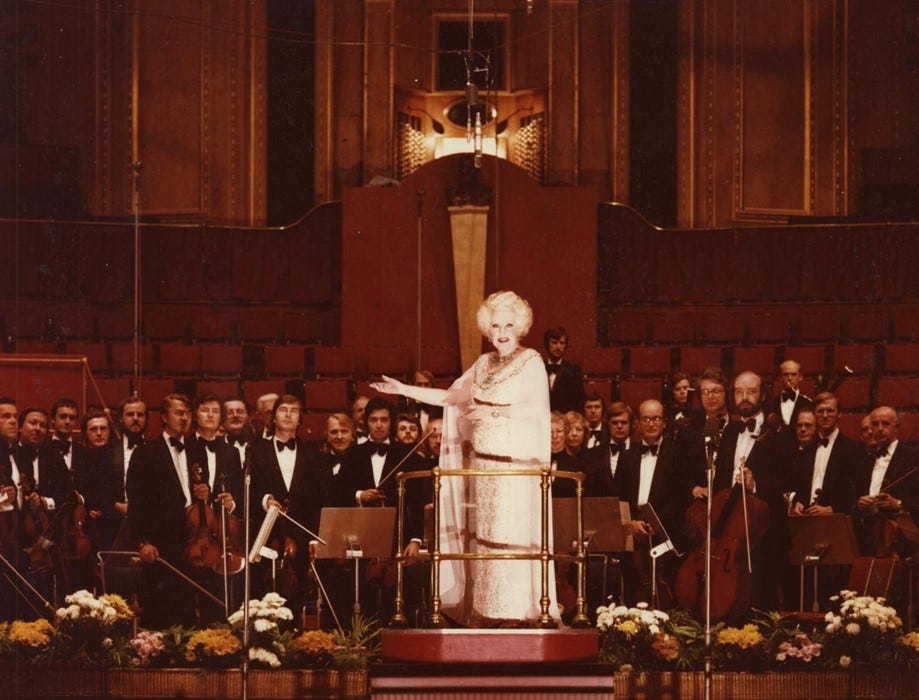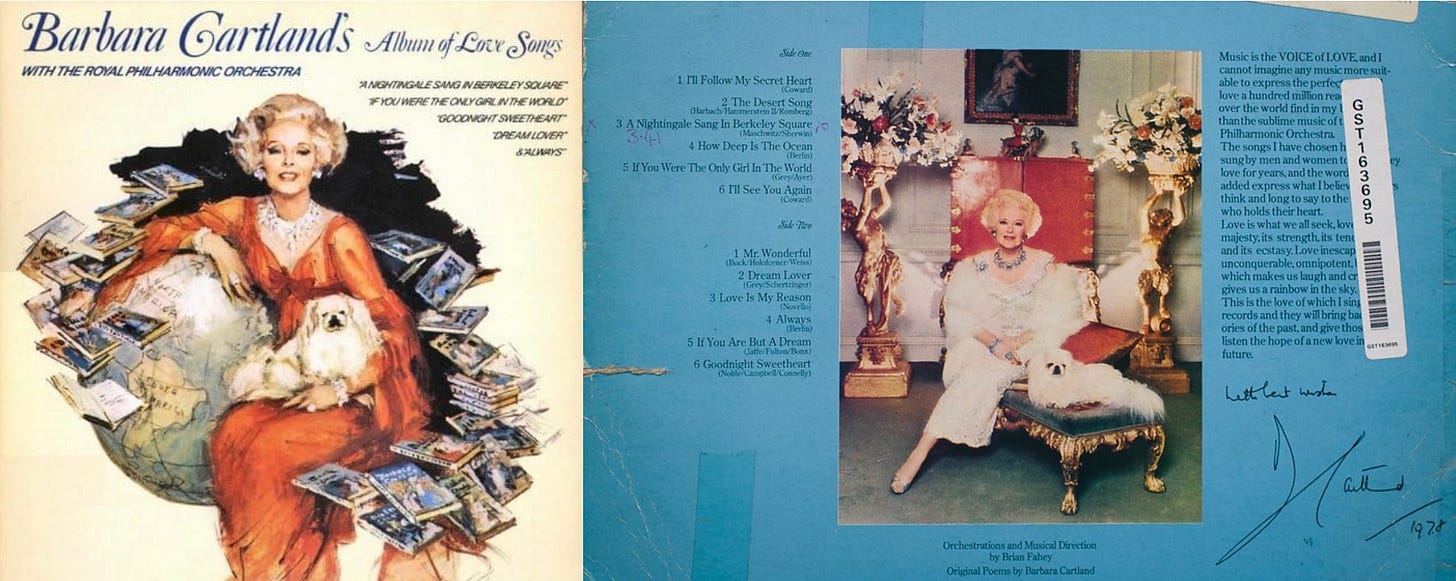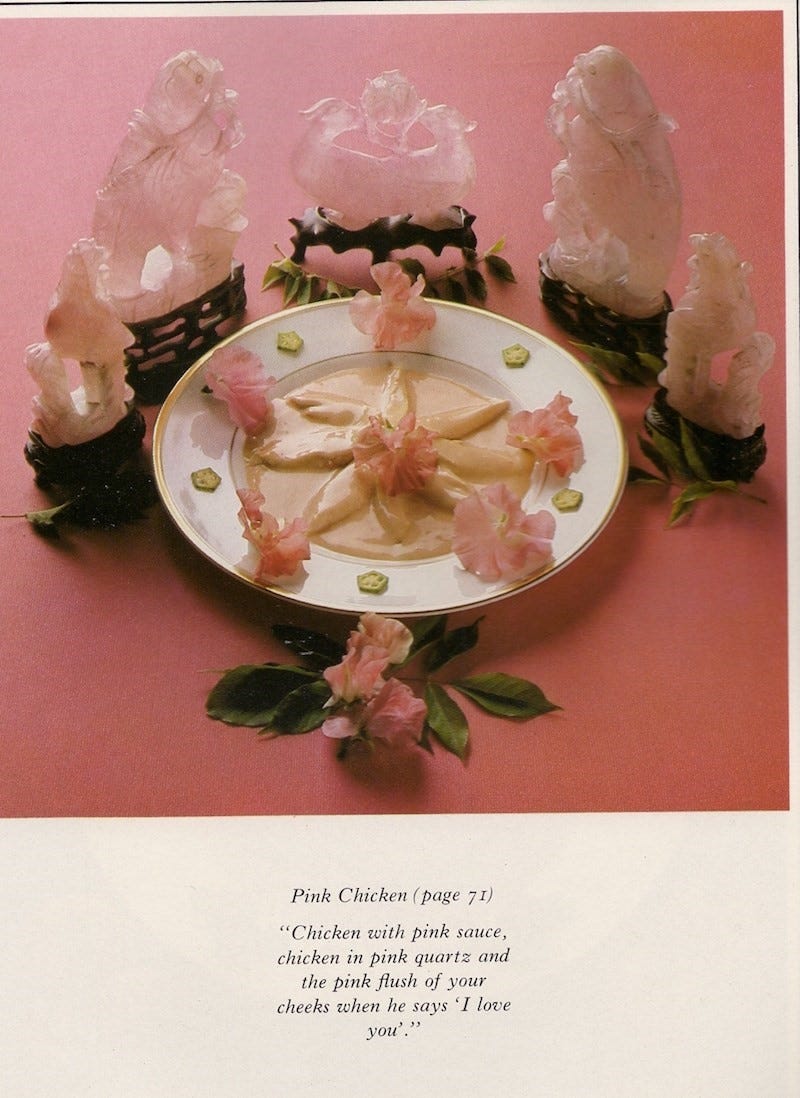Best Forgotten: Barbara Cartland's Album of Love Songs
The Falling Upwards Valentine's Day Special

In many ways, Barbara Cartland is the inimitable blueprint. Author of 723 books, The Queen of Romance rode in a white Rolls-Royce and dictated 6,500 words every afternoon to her secretary from a velvet sofa in a thirteenth-century manor.
Even if you’ve never read her work or don’t know her by name, you’d know her wispy bouffant of blonde hair, heavy pastel makeup, pink taffeta gowns and a Pekingese in her lap. A point of reference in everything from Little Britain to fashion shoots, she had a licensed board game, was a talk show fixture and in 1976 broke the Guinness World Record for the most novels written in a single year (twenty-three).
It wasn’t just romance novels that Cartland penned; she wrote biographies, plays, a cookbook which she boasted was used by the chefs in the House of Commons and a guide to married life that was banned in Ireland1.
She was a firm believer that older people had to keep their minds active. “People die of boredom, nobody ever died of hard work,” an eighty-six-year-old Cartland told Terry Wogan as she promoted her fourteenth book of that year. Though Cartland, who was born into the upper-middle class, may not have been aware of the physical toll of manual labour2, everything in her life was focussed around her work. She even claimed that the lurid ‘Cartlandese pink’ of her dresses, designed by Norman Hartnell and Sarah Percival, “helps our brain, helps you to be clever.”
It was this drive that led Cartland at the tender age of seventy-seven to conquer a new medium: singing.
The Big Banker
The origins of Barbara Cartland’s Album of Love Songs are a little unclear. It is easy, and probably kinder to yourself, to imagine that this was a vanity project financed by Cartland, but I'm not entirely sure.
In an interview with The Mail on Sunday, Cartland said, "The Royal Philharmonic Orchestra asked if I would choose romantic songs from my period for them to sing. I was so interested I decided I would sing twelve myself and made a record. I was the oldest woman ever to make her first album of love songs.”
That Cartland was a year older than the age Florence Foster Jenkins died at may give a hint as to the vocal quality you can expect on the album and why, nearly fifty years after its release, no seventy-eight-year-old has tried to beat Cartland’s record3.
The fact that The Royal Philharmonic went ahead with the project even with Cartland fronting it suggests some kind of financial incentive on her part, but, State Records, who released the album went as far as announcing it at the WEA Sales Conference, a global trade fair, with hopes that were far from modest.
“She sounds better than Gracie Fields,” they said of Cartland, whose album they hoped would be their, “big banker for the Christmas market”.
Unfortunately, this big banker was about as reliable as Lehman Brothers in 2008.
Barbara’s Turn
This wasn’t Cartland’s first foray into the world of music. In 1957, she wrote two songs for society ladies, precursors to Countess Luann. The first, I’m in Love, was sung by her daughter, Raine, and the second, Luck’s In Love With You, was sung by The Duchess of Bedford, and the pair were released together to raise funds for Raine’s charity, Mrs Legge’s Fund for Old People.
Sadly, neither songs have the staying power of something like Money Can’t Buy You Class4. The singing stops being passable once the ladies get to the high notes and the lyrics read like a thirteen-year-old girl’s attempts to write a love song, full of half rhymes that Stephen Sondheim would shake his head at.
I’m in love, the stars are all shining I’m in love, and my heart starts to sing I’m in love, the clouds have aligning They glow like a wedding ring I’m in love, on a rainbow I’m riding I’m in love, my dreams have come true Crazily, wildly in raptures, I’m finding I’m in love with you
The reviews were mixed. John Oakland in Gramophone magazine wrote, “While it is obvious that neither artiste is a professional entertainer vocally, their voices have a certain something.”
NME voted it the worst record of the year.
Neither woman would record again, and Raine would eventually turn her attention to more noble pursuits, like torturing Princess Diana.
Barbara Cartland’s Album of Love Songs
Regardless of who footed the bill for the album, no expense was spared. The cover was illustrated by regular Cartland collaborator, Francis Marshall and Norman Parkinson took the portrait that featured on the back. It was recorded at Abbey Road Studios and produced by Norman Newell, who was better known for his work with Shirley Bassey and Petula Clark. Cartland not only had the backing of the Royal Philharmonic Orchestra, but the Mike Sammes Singers, who had previously worked with Frank Sinatra and a far less noteworthy Babs - Barbra Streisand. Being surrounded by so many professionals at the top of their game, you would hope that it would be impossible for things to go wrong. Rest assured, they did.
Even if Cartland wasn’t seventy-seven at the time of recording, I don't think she is a natural singer. That is to say, I don’t think she has any concept of how singing works, with no understanding of breath control, vocal placement or pitch. I'm no Maria Callas, but I can safely say Cartland is neither in tune nor the right key at any point of this album.
It is funny to listen to, but it's also quite boring because Cartland is so out of her depth and the support of the very accomplished backing singers and The Royal Philarmonic constantly draws attention to that. When she chickens out of the final note of I’ll See You Again, you can’t quite work out if it’s a blessing.
That’s not to say that Barbara didn’t bring a bit of Cartlandese magic to this album. As mentioned previously, Cartland chose the songs she would record, which included a range of tracks written by artists like Nöel Coward, Irving Berlin and Oscar Hammerstein, but it wasn’t enough for her to sing them as they were. Within each of the songs, Cartland incorporated two spoken word interludes she had written, which she referred as ‘poems’.
Some of the lines in the ‘poems’ are quite iconic. I have no issues with, “My dream lover has always been tall, dark, handsome, cynical and disillusioned with life until he meets me,” or, “Like every woman, I dreamt of being carried away by a Sheikh,” but I do think A Nightingale Sang in Berkeley Square is lovely enough without Cartland’s unnecessary addition.
I remember the scent of lilacs and syringa, the ancient houses silhouetted against the sky, the high trees overhead, a path leading towards a little temple in the centre of the garden. He was so handsome, we were both so in love with love. There was the magic of the night and youth that can never come again, except in our memories.
Bit of a downer, if you ask me, Babs.
I do have a theory as to why the interludes were included, and it’s not because Cartland was a writer, it’s because, without them, the album's running time is less than twenty-seven minutes5.
Babs goes bust
The album was released on November 3rd 1978. It did not chart.
Cartland was beaten by everything from the original cast recording of Jeff Wayne's Musical Version of The War of the Worlds to Boney M, with the Grease Original Soundtrack having an iron-clad grip on the No. 1 spot for thirteen weeks, all the way through to Christmas6.
A sensible woman, Cartland knew exactly where the blame lay - the price.
Her album had been released through Prima, State Records’s newest imprint that focussed on ‘top quality’ recordings of classical music, and this quality came at the high price of £4.39 - about £23 in today’s money.
Cartland was a charitable woman who cared about her fans. She knew they wanted to buy the album, they just couldn’t afford it, not when she was releasing a new novel every three to four weeks for them to also purchase. What fault of it was hers if her fans ultimately chose a book over the album? What was she to do?
She re-released the album at a significantly lower price, and like all well-bred ladies with largesse, she was most discreet about her charitable endeavours.
When my album of love songs which I sang with the Royal Philharmonic Orchestra was published I said, “It’s too expensive!” Now, after a fierce battle, you can buy it at a price which can be afforded by the people who read my books. The cassette of me singing the beautiful, unforgettable, nostalgic songs which make our hearts throb is only 1.99 pounds. Do listen to it and recall the rapture, the ecstasy and the irresistible joy of love - Barbara Cartland (taken from the reverse of the re-released cassette tape cover)
Once again, the album did not chart.
Cartland quickly moved back to writing, productive as ever. At the time of her death in 2000, she left 160 unpublished manuscripts. Her final novel, Love Finds The Duke At Last7, was only released in 2018. Most of her work is still in print, with more recent covers of certain books bearing the subtitle, “The Perfect Regency Novel for Fans of Bridgerton.”
Barbara Cartland’s Album of Love Songs has not enjoyed the same success, quickly falling into obscure novelty status. Thanks to users on bad music forums, I found out that it was used by French & Saunders as pre-show music at their live shows and featured as a mystery voice on a Danny Baker radio show in the 90s. At the time of publication, only one copy of the record is available to be purchased on eBay.
I have listened to this album far more than I should have, and I haven’t recalled the rapture, the ecstasy and the irresistible joy of love. If anything, it goes in one ear and out the other, and yet (and believe me, I say this with regret), this is probably the most comprehensive article about Barbara Cartland’s Album of Love Songs ever written.
This piece was not born out of any passion for Cartland or her music but because I went down so many rabbit holes unsuccessfully trying to find answers to my questions. I don’t know why the Royal Philharmonic Orchestra ever agreed to Cartland’s counter-proposal, who paid for the album to be produced or what the recording experience was like, and I probably never will.
Ultimately, I don’t know why this album exists, and I don’t think my theory that it’s a series of encrypted messages for Cold War spies holds much traction.
Barbara Cartland wrote 723 books, but she only has 883 monthly listeners on Spotify, and I worry most of them are somehow me.
Maybe this dogged pursuit of knowledge explains why this is the fifth consecutive Valentine’s Day I shall spend alone. But with no answers and nothing better to do, I too shall dream of being carried away by a Sheikh as I sob into my plate of pink chicken from Cartland’s cookbook, The Romance of Food.
Thanks so much for reading! This piece was such a labour of love and I would like to thank niche record enthusiasts, be they defunct bloggers, forum visitors or archivists - you are doing God's work. I think I want to thank my friend Charlie for bringing Barbara Cartland's Album of Love Songs to my attention in the first place, but I'm not entirely certain.
If you enjoyed my writing, please consider purchasing me this Norman Hartnell coat formerly owned by Barbara Cartland, it’s in my size and perfect for Valentine’s Day. If not, please consider subscribing or sharing with a link - it really helps!
If you would like to read similar pieces, you could read about Jeremy Irons’ ill-fated recording of My Fair Lady:
Or, you could read last year’s Valentine’s Day piece about my favourite romantic films you probably haven’t watched:
I also made a quiz for you! Which Barbara Cartland Novel Are You?8
If you have any further information about Barbara Cartland’s Album of Love Songs, please do get in touch!
Happy love day,
L x
When Ireland’s censorship laws were up for review in 1995, Cartland said she could not remember her offending guide very clearly but explained, "I was very young at the time." She was forty-nine.
She wouldn’t even dare to watch the sweat trickle down the muscular form of Mellors - an unthinkable romantic interest for her soft, delicate and noble protagonists.
Though, in the interest of fairness, Cartland was seven years younger than when Judi Dench gave a star-making performance as Old Deuteronomy in Tom Hooper’s Cats.
I wonder often if Raine would have performed at the Fashion's Night Out Celebration at Macy's Aventura Mall had they asked?
The biggest offender is Always, whose two interludes come to a total of fifty seconds.
It would be knocked to No. 2 by a Showaddywaddy compilation album the following week.
The story revolves around Ivan, Duke of Lavenham, whose world falls apart when he discovers that it is the sole goal of Penelope, his bride-to-be, to marry a Duke
I did write more questions, but you had to pay to ask more than five, which I was unwilling to do









My result was The Disgraceful Duke in your Which Barbara Cartland Novel Are You quiz! XXX